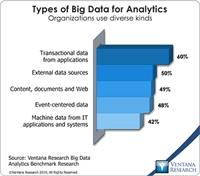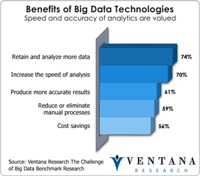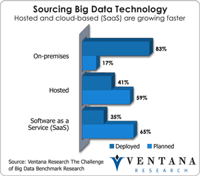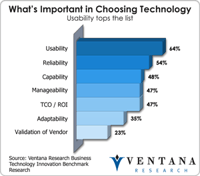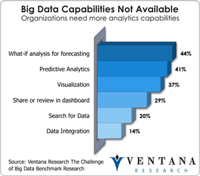Big data has become a big deal as the technology industry has invested tens of billions of dollars to create the next generation of databases and data processing. After the accompanying flood of new categories and marketing terminology from vendors, most in the IT community are now beginning to understand the potential of big data. Ventana Research thoroughly covered the evolving state of the big data and information optimization sector in 2014 and will continue this research in 2015 and...
Read More
Topics:
Big Data,
MapR,
Predictive Analytics,
SAP,
Human Capital,
Mulesoft,
Operational Performance Management (OPM),
Paxata,
SnapLogic,
Splunk,
Business Analytics,
Business Intelligence,
Cloud Computing,
Cloudera,
Hortonworks,
IBM,
Informatica,
Information Management,
Operational Intelligence,
Oracle,
Business Performance Management (BPM),
Customer Performance Management (CPM),
Datawatch,
Dell Boomi,
Financial Performance Management (FPM),
Information Management (IM),
Information Optimization,
Sales Performance Management (SPM),
Savi,
Sumo Logic,
Supply Chain Performance Management (SCPM),
Tamr,
Trifacta,
Strata+Hadoop
I had the pleasure of attending Cloudera’s recent analyst summit. Presenters reviewed the work the company has done since its founding six years ago and outlined its plans to use Hadoop to further empower big data technology to support what I call information optimization. Cloudera’s executive team has the co-founders of Hadoop who worked at Facebook, Oracle and Yahoo when they developed and used Hadoop. Last year they brought in CEO Tom Reilly, who led successful organizations at ArcSight, HP...
Read More
Topics:
Big Data,
Teradata,
Zoomdata,
Business Intelligence,
Cloudera,
Hortonworks,
IBM,
Location Intelligence,
Operational Intelligence,
Oracle,
Hive,
Impala,
Information Applications (IA),
Information Management (IM),
IT Performance Management (ITPM),
Strata+Hadoop
Organizations succeed through continuous planning to achieve high levels of performance. For most organizations planning is not an easy process to conduct. Planning software is typically designed for only a few people in the process, such as analysts, or organizations might use spreadsheets, which are not designed for business planning across an organization. Most technologies only allow you to examine the past and not plan for the future. For decades organizations have tried to focus planning...
Read More
Topics:
Big Data,
Mobile Technology,
Operational Performance Management (OPM),
Operations,
Business Analytics,
Business Collaboration,
Business Intelligence,
Cloud Computing,
Cloudera,
Governance, Risk & Compliance (GRC),
Business Performance Management (BPM),
Business Planning,
CFO,
Customer Performance Management (CPM),
finance,
Financial Performance Management (FPM),
Information Applications (IA),
Sales Performance Management (SPM),
Supply Chain Performance Management (SCPM),
Tidemark,
Workday,
Workforce Performance Management (WPM)
The big-data landscape just got a little more interesting with the release of EMC’s Pivotal HD distribution of Hadoop. Pivotal HD takes Apache Hadoop and extends it with a data loader and command center capabilities to configure, deploy, monitor and manage Hadoop. Pivotal HD, from EMC’s Pivotal Labs division, integrates with Greenplum Database, a massively parallel processing (MPP) database from EMC’s Greenplum division, and uses HDFS as the storage technology. The combination should help sites...
Read More
Topics:
Big Data,
EMC,
MapR,
HAWQ,
HDFS,
Pivotal HD,
Business Analytics,
Business Intelligence,
Cloud Computing,
Cloudera,
Hortonworks,
Location Intelligence,
Cirro,
Hive,
Information Applications (IA),
Information Management (IM),
Tableau Software,
Strata+Hadoop
SnapLogic, a provider of data integration in the cloud, this week announced Big Data-as-a-Service to address businesses’ needs to integrate and process data across Hadoop big data environments. As our research agenda for 2013 outlines, dealing with data in the cloud is very important to organizations. At the same time, businesses need to be able to integrate their big data with all their technology assets, as I pointed out recently.
Read More
Topics:
Big Data,
R,
Salesforce.com,
Operational Performance Management (OPM),
SnapLogic,
Business Analytics,
Cloud Computing,
Cloudera,
Data Integration,
Information Management,
Customer Performance Management (CPM),
Information Applications (IA),
Information Management (IM),
Sales Performance Management (SPM)
LucidWorks addresses the growing volume of information now being stored in the enterprise and in big data with two products aimed at the enterprise with search technology. Though you may not be familiar with LucidWorks (previously known as Lucid Imagination), the company has for many years contributed to Apache Lucene, an open source search project, and commercialized and supported for it for business.
Read More
Topics:
Big Data,
MapR,
Business Analytics,
Business Intelligence,
Business Mobility,
Cloud Computing,
Cloudera,
Hortonworks,
Customer Performance Management (CPM),
Information Management (IM),
Sales Performance Management (SPM),
Search,
Workforce Performance Management (WPM),
Strata+Hadoop
In our benchmark research in predictive analytics we’ve uncovered some intriguing tools for taking advantage of big data in the enterprise. Revolution Analytics, which we analyzed earlier this year, this month introduced its 6.0 release. Revolution extends the open source statistical programming language R with capabilities you would expect out of enterprise software. The company has grown substantially over the last several years and has an impressive list of more than a hundred customers in...
Read More
Topics:
Big Data,
Linux,
Operational Performance Management (OPM),
Predictive,
Revolution,
Business Analytics,
Business Intelligence,
Cloud Computing,
Cloudera,
Business Performance Management (BPM),
Data Mining,
Strata+Hadoop
Through a series of acquisitions and organic development over the last five years, IBM has established itself as a leader in enterprise big data for business analytics. I recently wrote about IBM Smarter Analytics, which brings together the company’s portfolio of software, systems and services from analytics to big data. But supporting big data requires the ability to access many sources of information; our benchmark research on big data found that more than half of organizations require...
Read More
Topics:
Big Data,
Social Media,
Sustainability,
Vivisimo,
Business Analytics,
Business Collaboration,
Business Intelligence,
Business Mobility,
Business Technology,
CIO,
Cloud Computing,
Cloudera,
Governance, Risk & Compliance (GRC),
IBM,
Information Management,
Information Technology,
Location Intelligence,
Operational Intelligence,
Business Performance Management (BPM),
Customer Performance Management (CPM),
Financial Performance Management (FPM),
Information Applications (IA),
Information Management (IM),
IT Performance Management (ITPM),
Sales Performance Management (SPM),
Supply Chain Performance Management (SCPM),
Workforce Performance Management (WPM),
Strata+Hadoop
Managing large volumes of enterprise data continues to challenge IT organizations as they deal with administration and storage of no longer just terabytes but now petabytes of data and costs increase accordingly. This massive size of data complicates the underlying issues of where and how to store it easily in low-cost hardware and manage the data efficiently. One attempt at a solution is Hadoop, an open source community-based project. It began as part of Yahoo and was led by Doug Cutting, who...
Read More
Topics:
Cloudera,
Data,
Information Management (IM),
Strata+Hadoop
Managing large volumes of enterprise data continues to challenge IT organizations as they deal with administration and storage of no longer just terabytes but now petabytes of data and costs increase accordingly. This massive size of data complicates the underlying issues of where and how to store it easily in low-cost hardware and manage the data efficiently. One attempt at a solution is Hadoop, an open source community-based project. It began as part of Yahoo and was led by Doug Cutting, who...
Read More
Topics:
Cloudera,
Data,
Information Management (IM),
Strata+Hadoop



